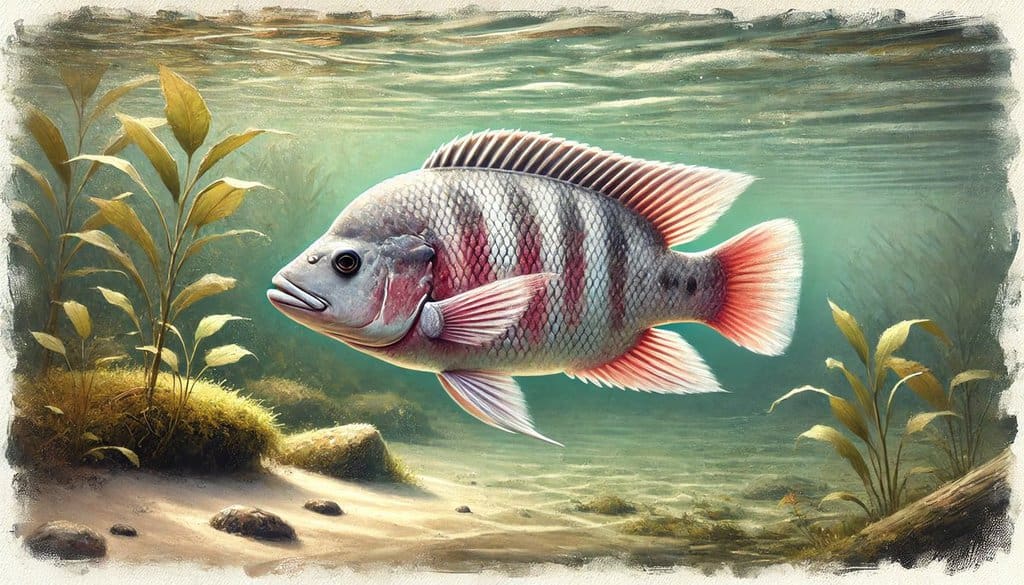Nile tilapia is a popular choice for aquaponics systems due to its rapid growth, adaptability, and tolerance to various water conditions. This hardy species is prized for its mild, white flesh and efficient feed conversion ratio.
Natural Habitat and Behavior
Origin and native environment: Nile tilapia originates from African freshwater habitats, including rivers, lakes, and streams[4].
Natural behavior: In the wild, Nile tilapia establish social hierarchies with dominant males controlling prime nesting sites. They are schooling fish and typically feed during daylight hours[4].
Temperament: Generally peaceful, but males can become territorial, especially during breeding.
Compatibility: Can be kept with other peaceful fish species, but may outcompete them for food.
Water Requirements
Temperature Range:
- Ideal: 27-30°C (80.6-86°F)
- Breeding occurs when water reaches 24°C (75°F)[4]
pH Level:
- Optimal range: 6.5-8.5
- Tolerates a wider range, but avoid sudden fluctuations[3]
Water hardness: Prefers moderately hard water with a carbonate hardness between 150 and 350 ppm[2].
Oxygen Levels: Above 3 ppm
Ammonia/Nitrate Sensitivity: Sensitive to high ammonia levels, especially at higher pH and temperature. Maintain ammonia below 0.5 ppm[1].
Tank or Pond Setup
Tank/Pond Size Requirements: Minimum 50 gallons (189 liters) for a small group, with at least 10 gallons (38 liters) per adult fish.
Filtration & Aeration: Requires efficient filtration and good aeration, especially in densely stocked systems[1].
Lighting Considerations: Natural light cycles are beneficial, but not critical.
Tank Decorations/Substrate: Provide hiding spots and open swimming areas. Substrate is optional but can harbor beneficial bacteria.
Feeding Requirements
Diet: Omnivorous, accepting a wide range of foods including algae, plants, and small invertebrates[5].
Feeding Techniques:
- Feed 2-3 times daily
- Offer a balanced commercial tilapia feed
- Supplement with vegetable matter or algae
Supplements: Generally not required if using a high-quality commercial feed.
Growth and Reproduction
Growth Rate: Fast-growing, reaching market size in 6-12 months[5].
Physical Growth Indicators: Males typically grow larger than females. Tanks with only males tend to grow quicker as they don’t spend energy on mating.
Breeding Behavior:
- Maternal mouthbrooders
- Males build circular nests
- Females incubate eggs in their mouths[4][5]
Care of Fry: Remove fry to separate tank for better survival rates. Feed with finely ground commercial feed or live foods like infusoria. If you have lots of hiding places in your tank this could help with fry survival if you don’t separate them, but don’t expect high survival rate in a crowded tank with lots of grown fish.
Harvesting & Culinary Considerations
Growth to Harvest: Typically harvested at 450-700 grams (1-1.5 lbs), usually within 6-8 months.
Culinary Uses: Mild, white flesh suitable for various cooking methods. Popular in many cuisines worldwide.
Recommendations for Ethical Harvesting: Use ice slurry method for quick and humane harvesting.
Pros and Cons
- Fast growth rate
- Adaptable to various water conditions
- Efficient feed conversion
- Disease resistant
- Can become invasive if released into local waterways
- Males may become aggressive during breeding
- Requires warm water, which may increase energy costs in cooler climates
Overall Suitability: Excellent for beginners and experienced aquaponics practitioners alike, especially in warm climates.
Common Health Issues and Solutions
Potential Diseases: Susceptible to parasitic infections and bacterial diseases in poor water conditions.
Signs of Health Issues: Lethargy, loss of appetite, abnormal swimming behavior, visible lesions or parasites.
Treatment Recommendations: Maintain optimal water quality. Use salt baths for minor issues. Consult a fish veterinarian for serious problems.
Maintenance Tips for Long-Term Health
Maintenance Frequency: Weekly water testing and regular system checks.
System checks: Monitor temperature, pH, ammonia, nitrite, and nitrate levels regularly.
Handling Practices: Minimize handling to reduce stress. Use nets when necessary.
Winter/Summer Care: Maintain consistent water temperature, especially in outdoor systems.
Tank Compatibility and Stocking: Compatible with many plant species in aquaponics. Stock at appropriate densities to prevent overcrowding.
Closing Thoughts
Nile tilapia is an excellent choice for aquaponics due to its hardiness, fast growth, and adaptability. Its ability to thrive in various water conditions makes it suitable for both beginners and experienced practitioners. However, careful management of water quality and temperature is crucial for optimal health and growth.
More fish species for aquaponics
External sources:
[1] https://ejabf.journals.ekb.eg/article_169899_0a9e97c16ea878a1154a7419893306cd.pdf
[2] https://lakewaytilapia.com/How_To_Raise_Tilapia.php
[3] https://digitalarchive.worldfishcenter.org/bitstream/handle/20.500.12348/5471/97996e83be62f70ef25ae7af4e00f572.pdf
[4] https://en.wikipedia.org/wiki/Oreochromis_niloticus
[5] https://www.aquanet.com/tilapia-commercial
[6] https://www.ncbi.nlm.nih.gov/pmc/articles/PMC9640449/
[7] https://onlinelibrary.wiley.com/doi/full/10.1002/aff2.58
[8] https://www.aquanet.com/small-scale-tilapia-farming
[9] https://www.cabidigitallibrary.org/doi/full/10.1079/cabicompendium.72086

